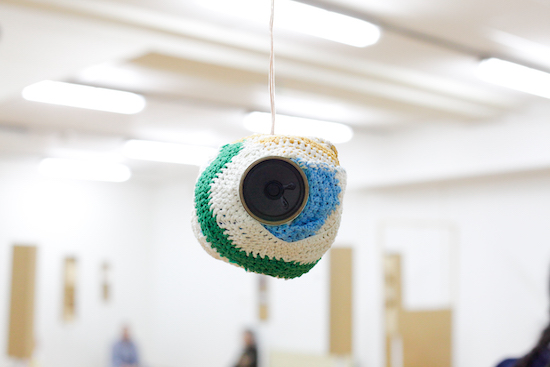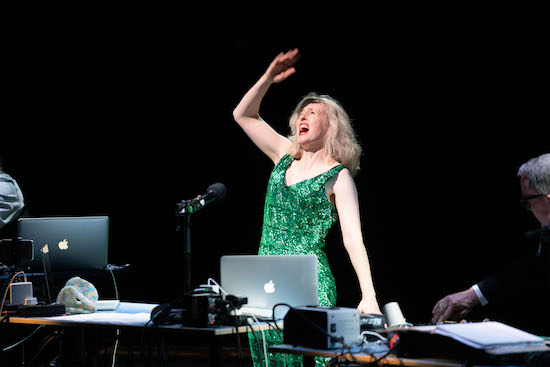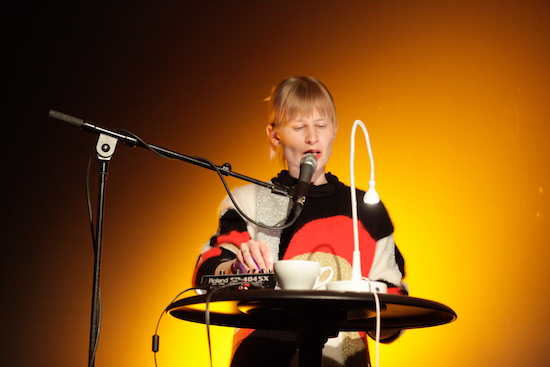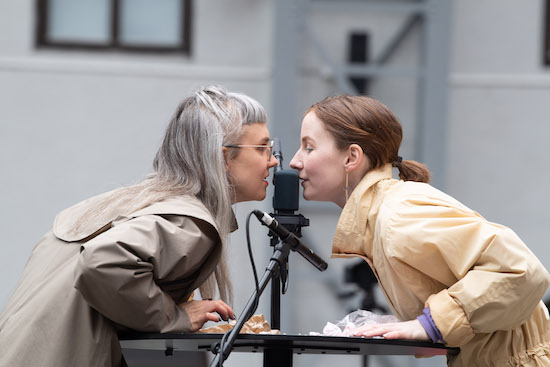Stine Janvin & Cara Tolmie
Jenny Hval plays piano, guitar, synthesizer, percussion, and something called an “autoharp”. She is an accomplished singer, song-writer, DJ, composer, arranger, and recording engineer. In addition to her own half-dozen solo albums, she has also contributed instrumental parts to records by Lindstrøm and Martin Hagfors. But onstage at this year’s Borealis Festival she eschewed all of these many and varied talents, employing instead only the voice, speaking.
The performance was not part of the festival’s talks programmes, but presented under the auspices of an evening called ‘Sounding Bodies’ dedicated to “the physical embodiment of ideas through … radical performances that teeter on the edge of visual art, music and dance.” Hval’s contribution, as she put it herself, was a “work” – or “work in progress” – a “composition” – or “a composition about composition.” Alone onstage, unaccompanied by any instrument, speaking and not singing, joined only occasionally by other (speaking) voices issuing from a small digital sampler in front of her, it was nonetheless clearly, and I think undeniably, music.
The voice, both sung and spoken, has played its part in musical performances for about as long as there has been such a thing as music – or speaking, for that matter. But at the festival in March, which takes place each spring in the Norwegian town of Bergen, I witnessed the spoken word come centre stage in a diverse range of contexts, such that I began to think of it as a kind of linguistic turn. Not merely a ‘setting of’ words to music in the manner of songs, psalms or operatic aria. Nor a ‘music infused with the spirit of poetry’, in the sense meant by Franz Liszt in the 19th century. Rather a becoming-music within language itself, an unleashing of language’s own inherent musicality.
For some time now, it has felt to me that indie book publishers like Dostoyevsky Wannabe, Fitzcarraldo, Repeater, or And Other Stories have started to act and feel more like the independent labels of the post-punk era, each with their own distinctive aesthetics, political urgencies, and serial cover designs, just like Factory, Mute, or Rough Trade. Rough Trade’s own recent entrance into the world of book publishing goes some way to confirm this. Not so long ago I read an interview with The Slits’ Viv Albertine where she compared writing books to writing records and Albertine is one of a whole slew of musicians publishing tomes in the last few years, from Morrissey’s memoirs to Shaun Ryder’s lyrics. As music becomes ever more immaterial, it is perhaps natural that artists used to making real physical things – like records, tapes – might still want to use their talent to make things they can hold – only now, the only mass-produced cultural artefact that people still actually hold in that way is the book. Jenny Hval herself published a novel last year. It is probably just as natural that performing artists like Hval should start to exhibit in their live shows the influence of the experience of book-making.
Hval’s set started almost like a simple speech in plain language, then almost imperceptibly became a deft counterpoint of spoken voices, present and absent, combined in ways that blurred the distinction between speech and song. Beatrice Gibson’s film, Deux soeurs qui ne sont pas soeurs, smashes the words of Gertrude Stein against the music of Lawrence Crane and then assembles itself form the fragments. Colin Self uses language redemptively, as a means of forging and sustaining temporary communities and collective identities. But what stuck out for me was a simple gesture that turned the act of reading into a performance strategy, loaded with potential meanings. Jennifer Walshe’s opera TIME TIME TIME was inhabited by multiple, teeming speaking voices. Mari Kvien Brunvoll’s composition felt like eavesdropping on a heated dialogue between non-human species. Stine Janvin’s collaboration with Cara Tolmie seemed to reach towards an ur-language, tied closely to the origins of music.

Speaker Park
Speaking at Bergen Kino on Friday night, immediately after the screening of her film, Deux soeurs qui ne sont pas soeurs, Beatrice Gibson confessed to having made the film somewhat “inside out – or upside down.” While most pictures come round to the soundtrack as the very last thought, in this case Lawrence Crane’s music was built into the picture from the very moment of its commission. On the other hand, the play, by Gertrude Stein, which gives the film its title and from which the film is ostensibly adapted, came later. Both were significantly chopped up and experimented with in the process of making the film. Stein’s original play finally becomes as much extra-diegetic music as structure, and Crane’s music becomes as much a structuring device as a soundtrack. Music as text, text as music, both equally beguiling.
At a certain point in Colin Self’s performance, in the bar at the Kunsthall on Friday night, he stopped singing, strutting, and generally setting the place on fire in order to stop and read. The electronic backing track continued to play. The lights shone. The audience paid attention. The show had not ended, nor paused. Up to that point, Self’s notebook had been kind of a prop, even part of his costume, a thing to be referred to for lyrics or ideas. At this point, however, he did not seem to be checking on the words for the next track. He simply performed the act of reading or let his reading become part of his performance. Perhaps if you looked very closely in that moment, you could see his brain dance to the words we could not hear but knew were there.

Jennifer Walshe
Timothy Morton did not read during the performance of the opera he wrote with composer Jennifer Walshe. But he was on stage, sitting still, eyes closed. He performed his thinking, which – neither musician nor composer nor performer, in any usual sense of the word –was his unique contribution to the piece. It was on the whole Morton’s words which sprung from the mouths of performers MC Schmidt, Áine O’Dwyer and Walshe herself. Words about time’s irreversibility, its different modes and speeds, attempts to think its unthinkability. These words were sometimes sung, but mostly spoken – and in a dizzying variety of voices, all the performers playing with different speeds and rhythms and timbres of their speech, overlapping in different ways, adding electronic effects. Language became a thing to be manipulated, a sound object.
Wrap is an artist-led production hub, a suite of studios, a centre for production in the south-east of Bergen. For a series of concerts at Borealis it was turned into a “speaker park”, an indoor space full of a bizarre menagerie of different loudspeakers designed and built by Jon Pigott and Roar Sletteland. The speakers themselves were the very opposite of your standard hi-fi ambisonics surround set-up. They looked like alien creatures or heaps of junk. Some vast woofers built into chairs that you would feel if you sat on them, rather than hear. Others tiny little tweeters whose only funciton was to vibrate a stick attached to a piece of paper that would shake and rattle when activated. Coming out of these strange Star Wars-like entities and spread all about the room, Mari Kvien Brunvoll’s twittering, twinkling, shimmering composition, composed specially for the set-up, felt uncannily like stepping into a conversation between alien creatures, eavesdropping on some inscrutable debate.

Jeny Hval
The collaboration between Norwegian singer-composer Stine Janvin and Scottish artist Cara Tolmie began with a strange, tentative encounter in the middle of Bergen train station and ended with the sharing of tea and cake. With just their voices (and a cinnamon bun) for instruments, the piece resembled a kind of ur-fika, a primitive grasping and scrabbling towards some common basis for communication. It brought to mind those episodes of Star Trek when the universal translator breaks down or the musicologist Gary Tomlinson’s conception of ‘proto-discourse’ as the common ancestor to both language and music, shared rhythms and shared gesture-calls, that reveal the inseparability of song and speech. It felt elemental; quietly, subtly bewitching.
“The festival is a temporary community,” as Borealis artistic director Peter Meanwell said on the Saturday afternoon at the city library. There was much talk, in general, about materiality and embodiment. But my experience was as much of a community of speakers as a community of bodies – or, perhaps, of the disintegration of any distinction between the two. For this musicking of language, a musicking from within, was also a queering of language and an experience of language’s violences, a wrenching of language from out of the body and into the air – sometimes painfully, brutally, as in the extraordinary set by B L A C K I E in the Kunsthall on Saturday night. A wild, visceral torrent of words screamed from somewhere buried, dug up and exhumed, over a whirlwind of dizzying electronics, like a horror film in an amusement arcade. This was, we were told, the Houston-based performer’s last ever set (at least under that moniker). It was a thrilling, almost terrifying thing, taking us beyond the places language can normally reach.
Borealis Festival takes place in Bergen, Norway, each March


